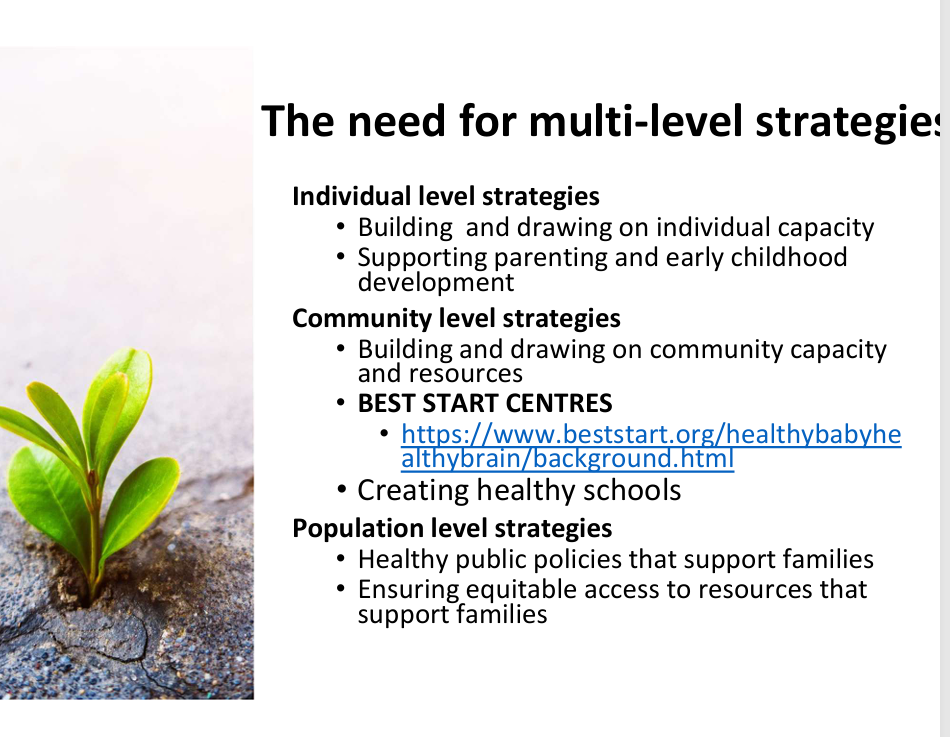W10 C9 - PROMOTING CHILDHOOD DEVELOPM
1/44
There's no tags or description
Looks like no tags are added yet.
Name | Mastery | Learn | Test | Matching | Spaced |
|---|
No study sessions yet.
45 Terms
why do the early years matter
lots of brain development happens
by age 4 90% size of brain develops
dont finish growing until we are 25-30 yrs old
why is the first five years of a childs life important
learning is rich in the first 5 years
early years are crucial for health well-being and lifetime after
more stimulus they receive is better - they are more absorbent to information = more learning, more development, mmore skill
impoverishd stimulation response = neglect, absence emotional connection, physical, touching, meeting baby needs hunger, crying, pain, ex. even not changing diaper
neglected or violent environments = develop different coping styles different set biological connections causing issues later on
child early on - physically aggrevis by school age, not socializing experiences to reduce physical responses into verbal communication
about brain development
size - depends on the number of neurons and neural pathways
how those connections work differ based on the exposure to stimulus
neglected - never been stimulated or exposed to things
stimulation - more exposed to stimulus

what are adverse childhood experiences (ACE)
based on a study by anda and felitti - adverse childhood expereinces study
measure adverse childhood experiences
physical and sexual abuse
emotional neglect
household dysfunction
(divorce, family incarceration, mental illness or addictions)
higher ACE = wrost outcomes on addictive behaviour, depression, anxiety, suicide
ACE scores of 4 or higher
more likely to smoke
7x more likely to have sex before 15
2x more likely to have cancer and heart disease
ACE score of above 6
30x more likely to attempt suicide
46x more likely to use drugs
key channel through which early adversity cause these damage is through stress
Questionaire areas - 67% of people have had adverse child hood experience, ex. not enough to eat, not enough child hood clothing, losing parent divorce, mental illness/suicid, substance use disorders, domestic violence, arrested family, verbal abuse, physical assaulted, emotionaly neglected, sexual abuse
ACE’S DIAGRAM
use to look at to calculate childhood experiences
as hcp how we related to childhood experiences: first memeory fo the hospital can be impactful ex. if we exercise neglect in some way - long lasting impacts
adversity - poverty, bullying in school
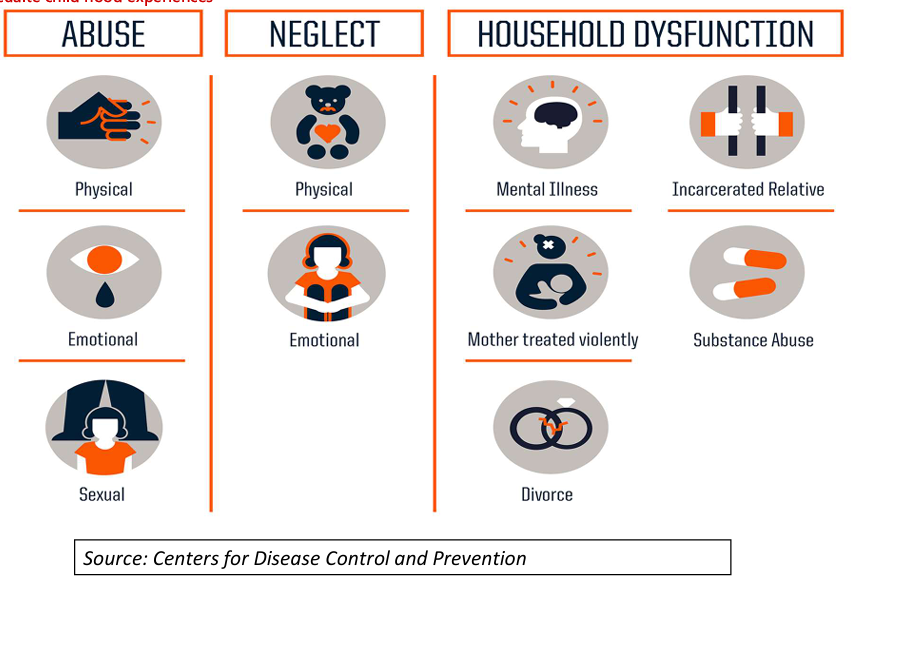
diagram of mechanisms by which adverse childhood experiences influence health and wellbeing throughout the lifespan
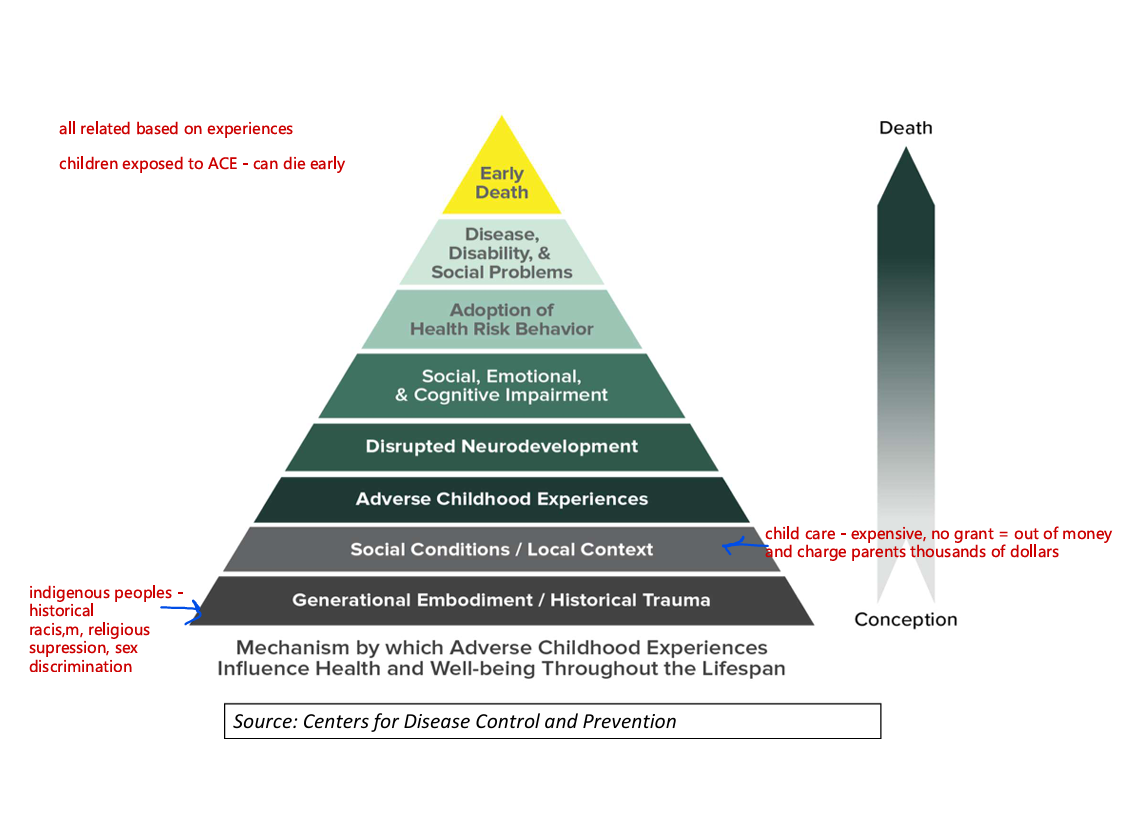
STORY - HOME ENVIRONMENTS - RATS
experiment - nothing about ACE but that they put rats and weigh them to check their growht and development about weight gian.
every week measured their growth - one tester noticied that some mom when the rat comes back to the mouse show them affection vs some mom who dont even care.. caring mom who licks and cares vs the other who does.
seeing fi that has imapact on their cognitive,emotional social development,
do another experienment about putting in seperate box and see if teh rats can find their way to the cheese - cared mom vs neglect mom - those babies who cared rlly confident and navigation, other rat - stuck to the corner, took a while until they though its the time to find food which also took a while - CONNECTION TO NEURAL PATHWAYS- hesistant when get to food but are hesistant - speaks ot cognitive development pathway and being developed in each environment impacting their confidence
importance of nurturing relationships
parenting and stress
attachment
PIAGET’S THEORY OF CHILDHOOD DEVELOPMENT Categories (important)
sensorimotor
preoperational
concrete operational
formal operational
this focuses on the thinking and cognitive development for kids
neglect - cna be unintentional but if they dont have that sensory experience - lack it
- importance of letting them fall , but not preventing everything, dont be overly cautious - be careful not dont voer protect it limits them
PIAGET’S THEORY OF CHILDHOOD DEVELOPMENT - SENSORIMOTOR
birth - 2 years
understands world through senses and action
at this stage it is about learning object performance in this stage
ex. peakaboo
1-2 years how is the mother going to stimualte the baby - talk about the senses
PIAGET’S THEORY OF CHILDHOOD DEVELOPMENT - PREOPERATIONAL
age 2-7 years
understands the world through language and mental images
not cause and effect mastery - think everyone sees the world as they see it
expand - looking at through symbols, intuition, imagination
language development - 3 yrs old more than 50% acquisition in this stage
offer textual piece - link to image
PIAGET’S THEORY OF CHILDHOOD DEVELOPMENT - CONCRETE OPERATIONAL
age 7-12
understands world through logical thinking and categories
they dont have abstrct thinnking cannot think outside the box
no theoretical thinking
skill learning - inductive reasonging, logical
PIAGET’S THEORY OF CHILDHOOD DEVELOPMENT - FORMAL OPERATIONAL
age 12 years onward
understands world through hypothetical thinking and scientific reasoning
deductive reasoning develops
plan in advance
thinking beyond present moment
think abt concepts in major level
tasks of childhood - eriksons developmental model - stages
TRUST VS MISTRUSTS
infancy - 18 months
autonomy vs shame
18 months - 3 years
initiative vs guilt
3-7 years
industry vs inferiority
8-12 years
identity vs role confusion
adolescent year
this focuses on the psychological aspects
tasks of childhood - eriksons developmental model - TRUST VS MISTRUST
Infancy -18 months
trust
safer as go on
attachment
ex. needing diaper changed and they change when needed
mistrust
anxious avoident future
ex. hunger and food is not given
tasks of childhood - eriksons developmental model - autonomy vs shame
18 months - 3 years
discovering our bodies
explore and self acceptance
autonomy - self independence
shame - discourage self, about body, impulses
ex. toilet training
tasks of childhood - eriksons developmental model - INITIATIVE VS GUILT
3-7 years
efficacy in the world - is what i do okay?
discovering things
ex. trying running, painting
what u like , capable, interactions
if this learning is stunted someone develops impoerly
allow imagination otherwise guilty about what i like or want to do
ex, spilling stuff and getting yelled at - GUILY DEVELOPMENT
tasks of childhood - eriksons developmental model - INDUSTRY VS INFERIORIRTY
8-12 years
developing work ethic
interest
we are different from other people thoughts are unique
disciplined when its appropriate happens at this stage - knowing ethics
positive reinforcment - work hard soemthing we enjoy
negative feedback and no encouragement
why bother working hard whats it gonna lead to
tasks of childhood - eriksons developmental model - IDENTITY VS ROLE CONFUSION
adolescent years
developing sense of self
seperate ourselves from our families
soemthing unique to ourselves
roles and societies in different settings
not allowed autonomy to identify who u want to be - role confusion
social expectations - influential here
peers - listened to more than their mom or parent - that is their role model
successful mastery od developmental tasks leads to a child who can:
engage in age appropriate independent decision making
look at issues through multiple perspectives
problem solve effiectiveyl at an age appropriate level
develop and maintain age appropriate relationships
demonstrate a sense of resilency
give sense of confiedence that they can continue
egocentric perspective - lack empathy and feeling we are centre
need to develop centre of compassion and empathy
the key things of early years development
physical development:
this is dexterity, hand eye coordiantion
language - estimate that by the age 3, 50% of language i in place
more u talk, better coping of the language to use
ex. using spoon, coordination…..
cognitive development
reading adn writing
lack of exposure - struggles in liteacy
more exposure - better acquisition
social development
empathy, conflict resolution - reaction
empathy
single greatest inhibitor of the propensity to violence
never taught - be expereince
age appropraite - activities or skill
emotional development
self cofidence, resilience
optimism/resilience
children who were likely to succeed academically were those who had skills of optimis, resilience, social agility
think positive - be problem solver
praise child 0 sense of accomplishment
self condifence
encoruage your child to be a problem solver early in life
self control and will power
delaying gratification predict better academic outcomes
character strength
can character strength be taught
readiness, ability , determinants, lived expereinces
getting excited about the learning process, exploring and get the answer
experiement
kids exposed to more poverty - more inclined to eat it and not trust if more harm
those who waitied - better outcomes
*********** FACTORS CENTRAL TO CHILD DEVELOPMENT
relationships
attachment and ecurtiy and mental
developing resilence and other charcater skills
nutrition
access to healthy foods and lief chances
developing healthy eating patterns
physical activity
opportunities for physical activity
opportunities for cognitive development
literacy, numeracy, language acquisition
support exploration
improving early childhood development WHO guideline
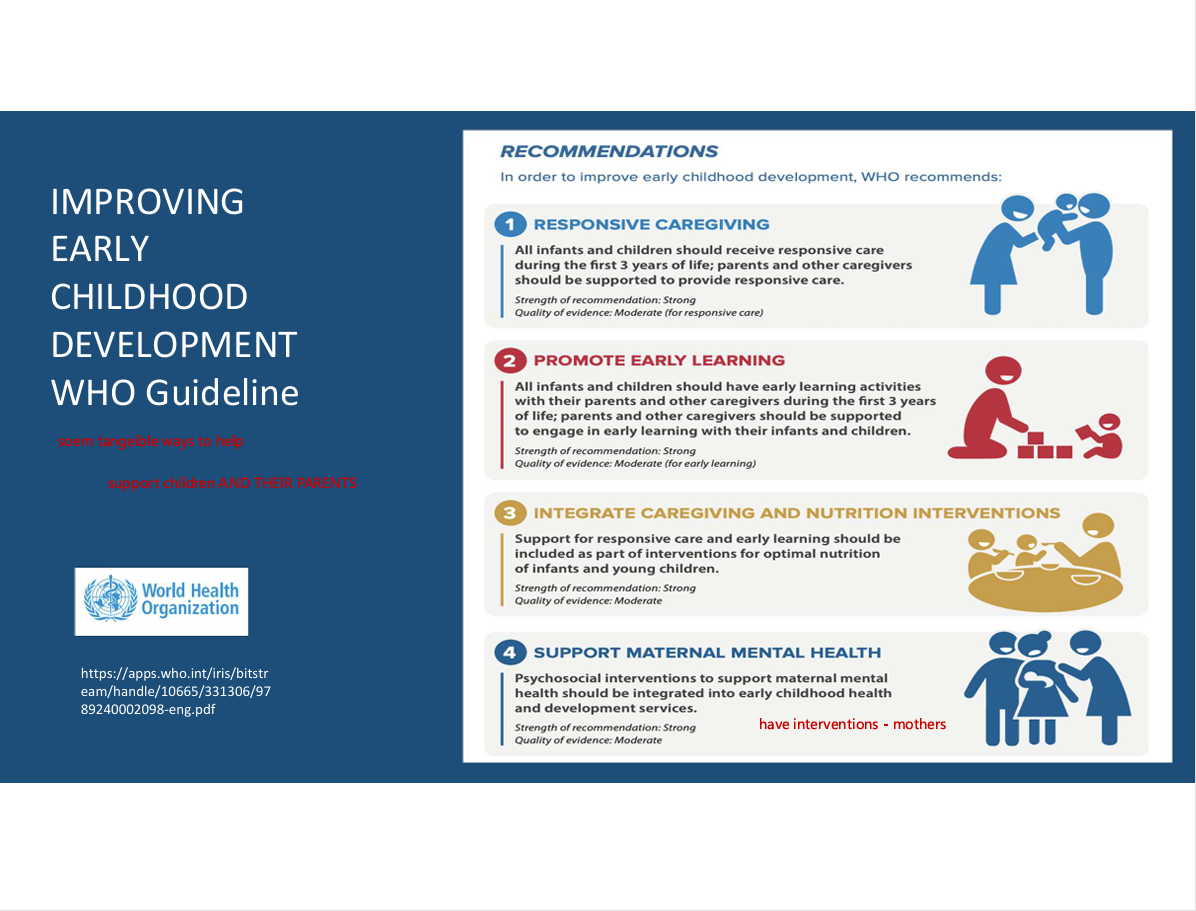
what are the determinants of early child hood development
income
evidence that health gradient in childhood development exists according to social adn economic factors
effective parenting adn family functioning
parental invovlement in childrens early learning is important to success across all groups - consistency
positive social interaction
can improve childrens progress through activities that engage and stretch the childs imagination - positive effect
play
playing allows children to practice skills, demonstrate what they learn, understand, think, and establish self confidence adn self esteem
motivated, engaged to learn skills, problem solve, socila interaction - learn through playing
age appropriate
poor neighbourhoods
less likely to ahve access to timely assessment adn treatment
well resources, safe, parks, bikes expensive
safe home environment
a good household culture can ride out the effects of poverty
neighbourhood early childhood development
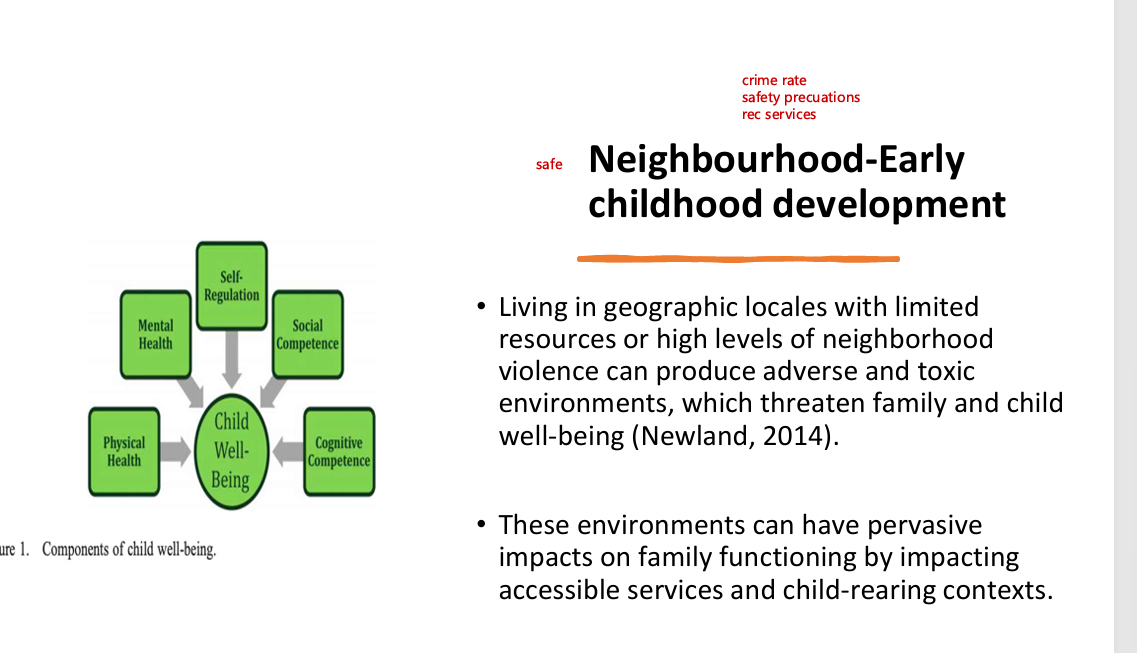
poverty has lasting impacts - early catastrophe
• Families in poverty are much more likely to struggle with parental mental-health issues, such as: distress, depression, and high stress levels, which collectively can impact family functioning, parenting behaviours, level of parent involvement, quality of parent–child interactions, and a wide range of child outcomes (Newland, 2014). •
Study in Kansas City showed that children in richer homes were exposed to 30 million more words by age 3 than children in lower income households (Hart & Rislev, 1995).
• Not just words – types of words, as well as context:
• Higher SES children heard more affirmative words than prohibitions (more encouragement than discouragements
poverty affects development
think about how can the following affect healthy development
access to healthy food
health at risk
not enough nutirnets to sustain body
healing abilities improper
precarious housing
exposure to violence - scary, starting
access to safe play space
access to recreational activities
lack income - stress parents
stress in parents
intergenerational persistence of poverty
a persons life outcomes are closely related to family charcateristics
parental outcome
ses
parental education
born in lwoer socio eocnomic does not mean they wont have highe educatin - stong careers but cna make thing smore difficult from an earlier stage
children from low income families
more likely to have lower income as adults as compared to children from higher SES
chidlren with multiple risk factors from generation poverty are more likely to
expereince engative outcomes later in life
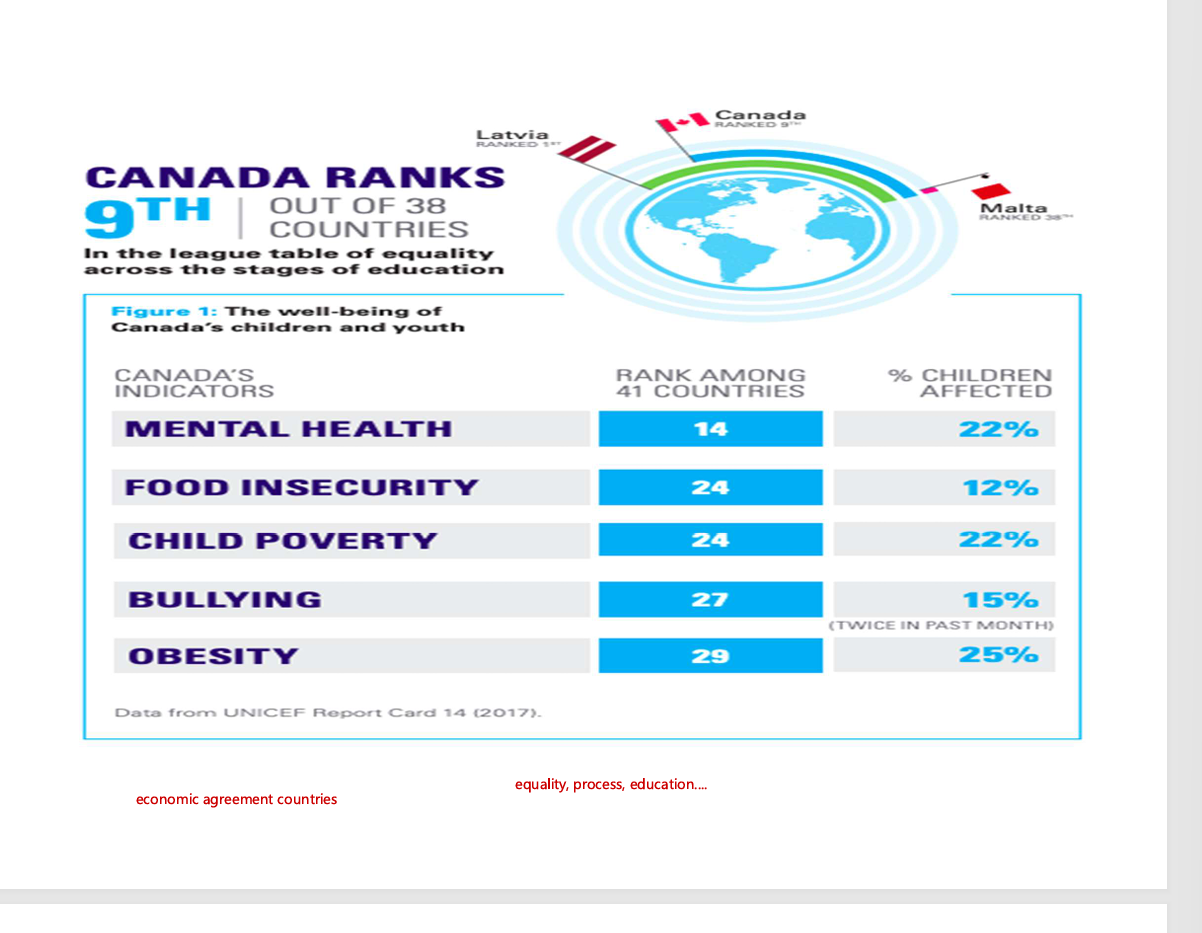
resilence does not mitigate poverty completely
Despite initial higher cognitive and social skills, adult life outcomes of low SES resilient kids are lower than those of advantaged/privileged underachievers. •
In 1 study, only nine per cent of resilient men and three per cent of resilient women attained a degree versus 23 per cent and 22 per cent respectively of privileged underachieving men and women.
• Resilient women were more likely to be economically inactive than their more privileged counterparts
This suggests that SES has a very strong influence both on individuals’ early development and on life chances. (Schoon & Parsons, 2002
resilent and motivated - fewer degrees, still have advantages provided as support and get throgh shcool
positive learning environment can extend to childcare
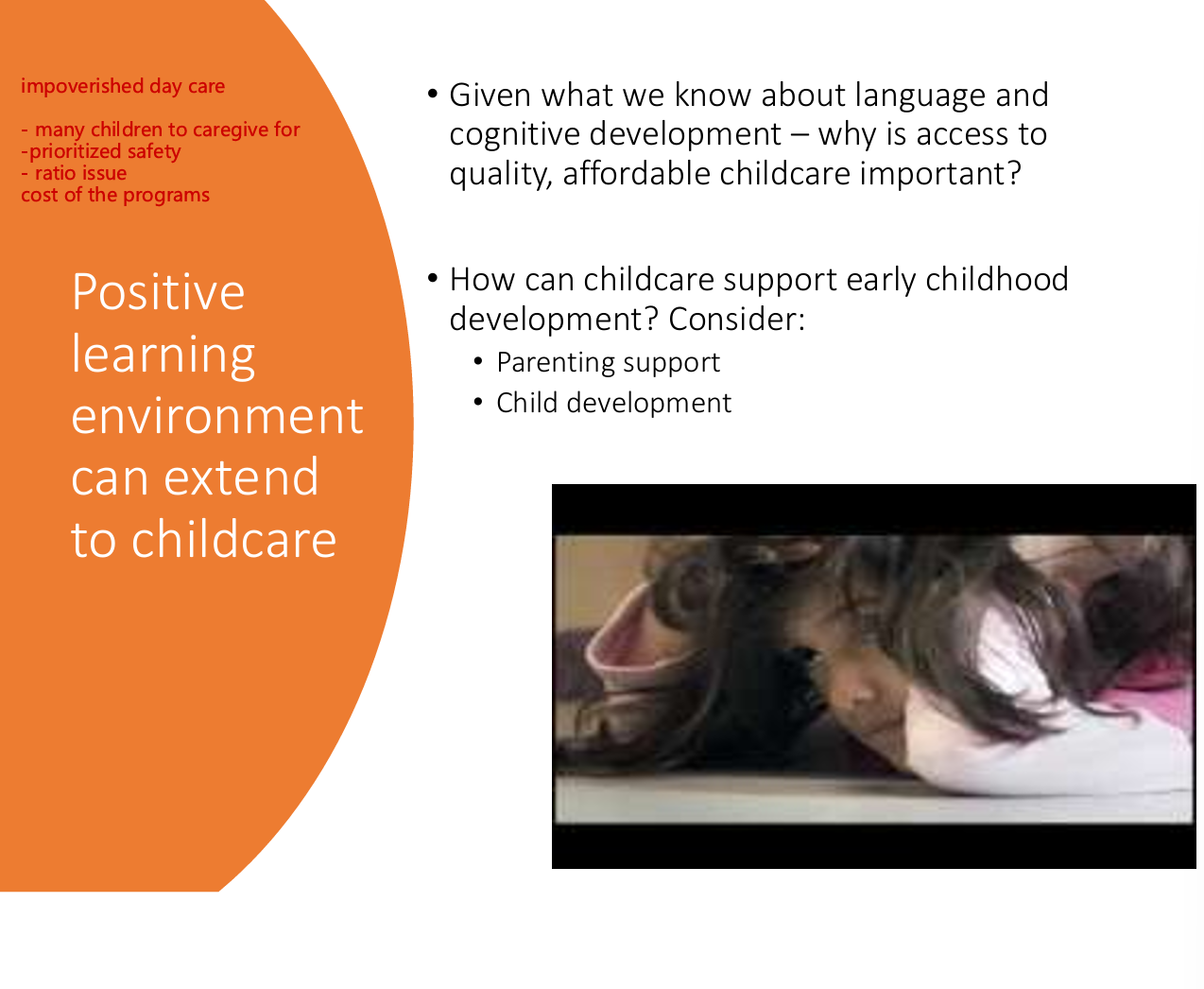
there is a alck of accessible, affordbale child care in canada
Lack of social policies to support healthy child and family development •
Evidence on OECD nations’ spending on childcare and pre-primary spending show that Canada is 36th of 37 nations •
Despite Federal promises to create a national childcare program, one does not exist in Canada
increase access to childcare
governemnt is slowly working toward 19$ a day childcare
home learning environment matters - can mitiagate effects of poverty on cognitive development
A supportive home learning environment can help mitigate the negative impacts of poverty on cognitive development
• HLE has a very powerful effect on children’s development at three to four years of age.
• A better HLE is associated with increased cognitive and social abilities, including ‘cooperation / conformity’, ‘peer sociability’ and ‘confidence’.
• The effect on cognitive development is particularly pronounced. The persistent effects of HLE are still noticeable at age 10
enriching home environments, home conflict how we grant social contact
who si repsonsible for early childhood development
parents
poor parenting skills - strong predictor of antisocial behaviour
family
family members who could provide support now live hundreds of miles away
communities -
all memebrs of the community have a responsbility for the health development of children
government
provision of accessible social programs
sense of responsibility to other children in the environment
communal thought
y do some communities have more access versus others
diagram for support a healthy child development
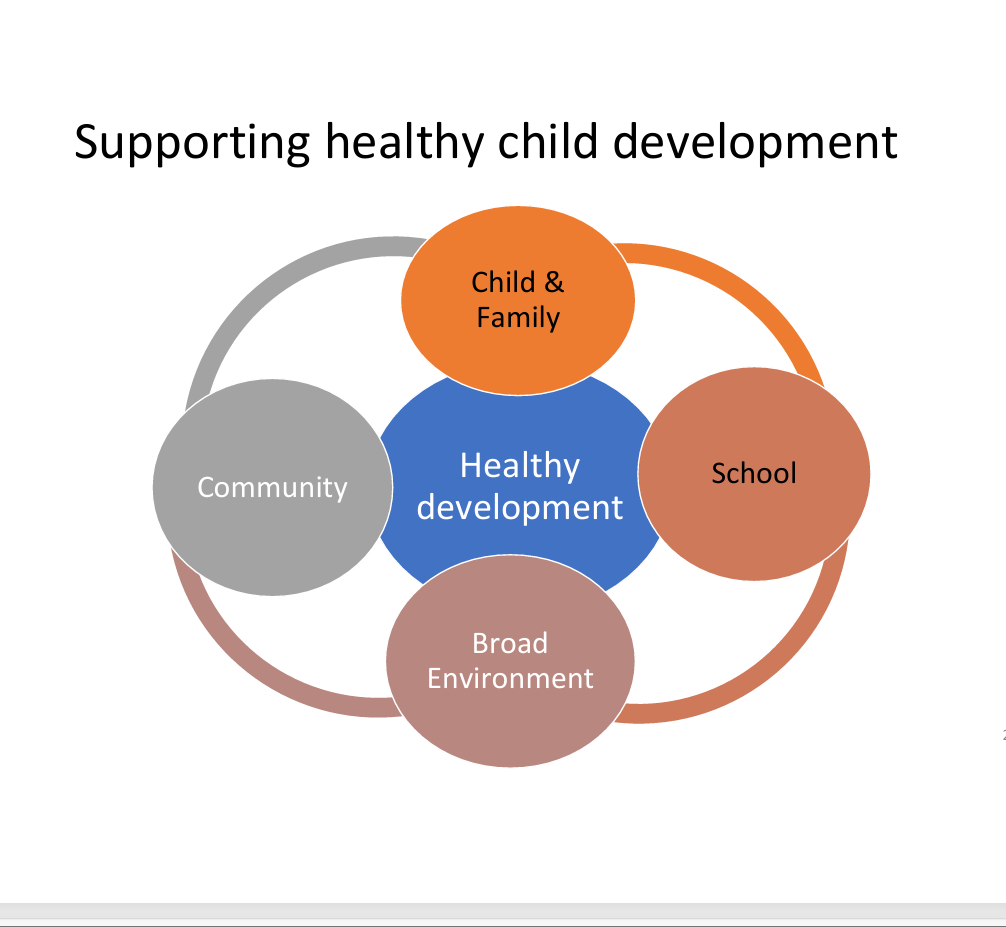
comprehensive school health *****
Health and Education are interconnected
• understands that schools can directly influence students’ health and behaviours • recognizes that healthy young people learn better and achieve more
• encourages healthy lifestyle choices, and promotes students’ health and wellbeing
• Helps students develop the skills needed for academic success and to be physically and emotionally healthy for life
• Better-educated individuals are healthier
4 components distinct but interrelated
social and physical environment
teaching and learning
partnerships adn services
healthy school policy
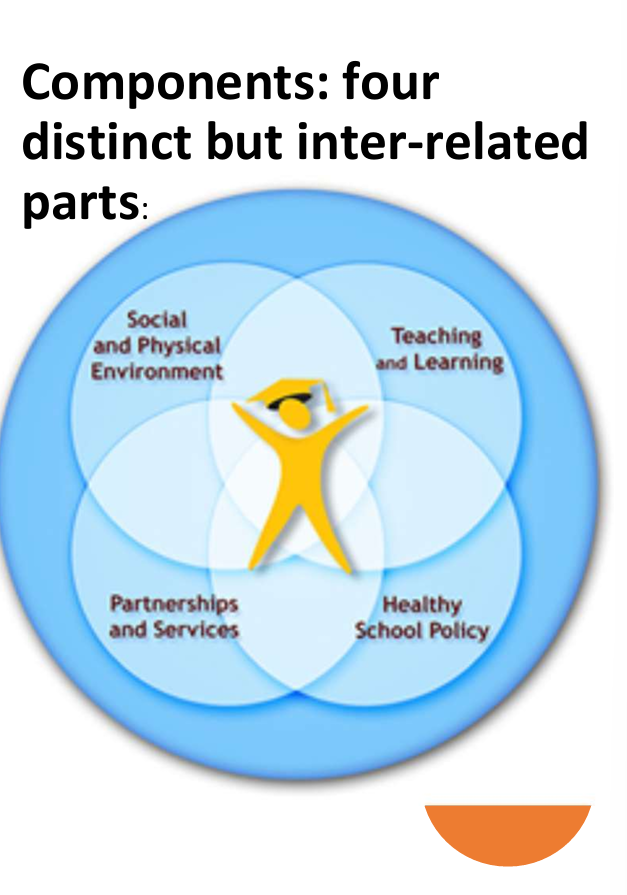
what are the 4 compoents of comprehensive school health
4 components distinct but interrelated
social and physical environment
teaching and learning
partnerships adn services
healthy school policy
compoents of comprehensive school health SOCIAL + PHYSICAL
social
promoting quality of the relationships
emotional wellbeing of students
relationships with families and teh wider community
supportive of the school community builing competence, autonomy, connectedness
physical
buildings , grounds paly space, equipment
sanitation, air cleanliness, healthy foods
promote student safety and connectedness and minimize injury
safe, accessible and supportive community
compoents of comprehensive school health - TEACHING AND LEARNING
formal and informal provincial/territorial curriculum, resources and associated activities
knowledge, understnading and skills for students to improve their health and wellbeing
professional development opportunities for staff related to health and well being
compoents of comprehensive school health - HEALTHY SCHOOL POLICY
policies, guidelines, and practices that promote and support student well being and achievement
ex. respectful, welcoming school enviornment for all
compoents of comprehensive school health - PARTNERSHIPS AND SERVICES
building connections between the school and students families
supportive working relationships among schools, organizations and representative groups
health education and other sectors working together to advance school health
community and school based services tht support and promote health adn wellbeing
nurses role in school health promotion
assessment, support, counselling and referral of students to needed services
health educaiton and skill development with students, families , school staff
provision of some clinical services per locally identified need
school based health or wellness clinics or youth health centres in secondary schools
consultations with school staff
participation in case conferences
communication and coordination with families via school visits, home visits, calls
coordiantion with other service or care provider
PHNS providing counseiling esrves to students on stress or coping related issues, self esteem, sexual health relationship difficulties and lifestyle issues
CHILDHOOD OBESITY IN CANADA
IMPORTNACE OT NOTE THE PHYSIOLOGICAL OUTCOMES

physical activity requirements for children
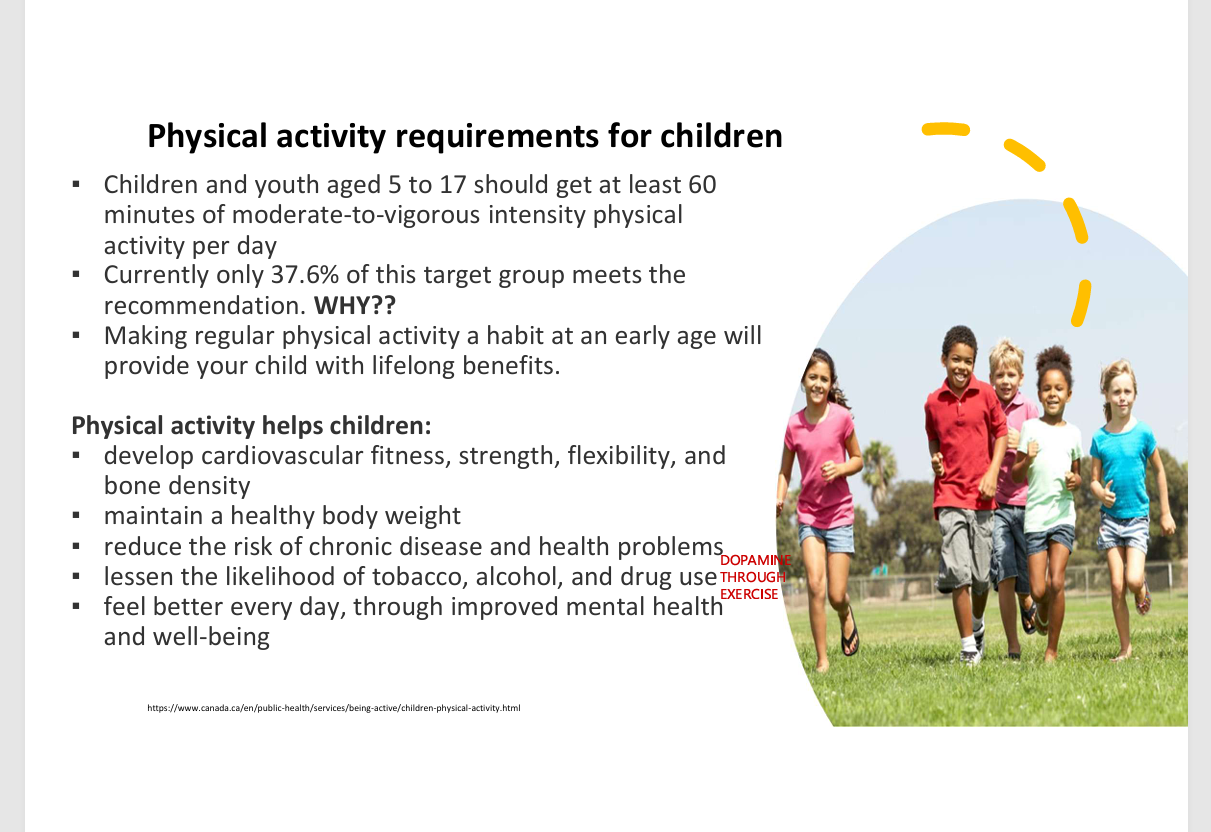
reccomendations - physicap activity for kids
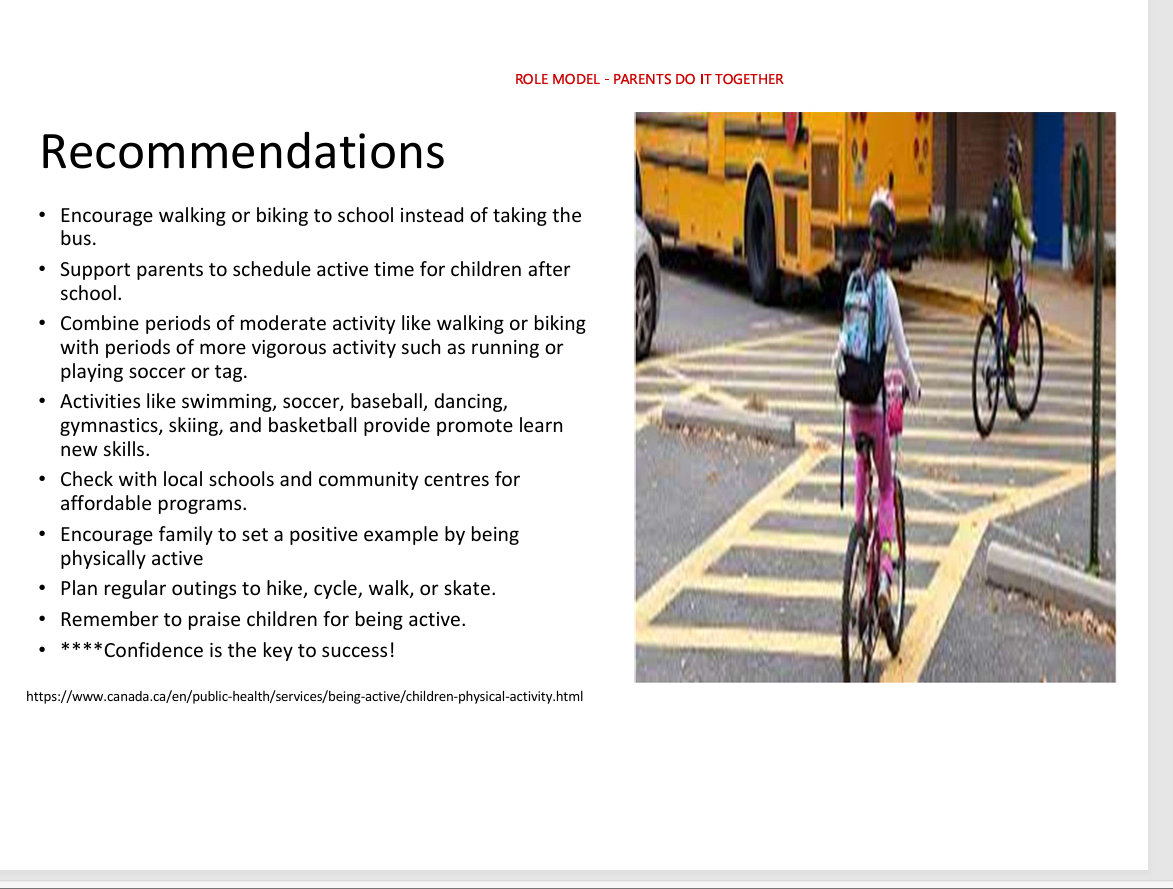
health promotion and safety across the developmental stages of childhood
early learning
nutrition
health
respoonsive caregiving
security and safety
the need for multi level streategies
